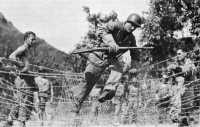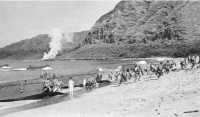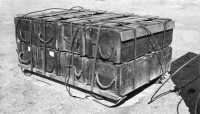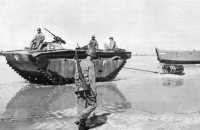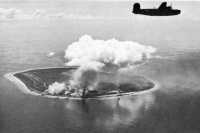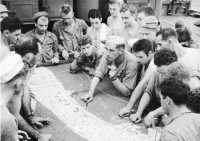Chapter 3: Preparing for the Attack
Training
The Marine V Amphibious Corps, under General Holland Smith, was responsible for supervision of the ship-to-shore amphibious training of all units scheduled to take part in the invasion of the Gilbert Islands. General Richardson, commanding general of United States Army Forces in the Central Pacific Area (USAFICPA), was in charge of the rest of the training of Army units for this operation in addition to discharging the logistical and administrative duties of his command.
Before its specific assignment to the Gilberts operation, the 27th Infantry Division had been conducting preliminary amphibious training for a period of about eight months.1 The division had been a National Guard unit from New York State and was called into Federal service in October 1940. Beginning in March 1942 it was transferred to Hawaii and for the next year and a half served as base defense force, first in the outer islands and later on Oahu after the 25th Infantry Division was sent to Guadalcanal in November 1942. While in Hawaii the division was triangularized, losing its fourth regiment, the 108th Infantry, to the 40th Division. This left it with the 165th, the 105th, and the 106th Infantry Regiments.2
Since November of 1942 the division’s commanding general had been General Ralph Smith. His previous wartime duty had been with Military Intelligence Division of the War Department General Staff (G-2) and with the 76th Infantry Division at Fort George G. Meade.3
In spite of the fact that its original duties in the Hawaiian area were largely defensive in character, the division early commenced to make preparations against the day when it might be called upon to participate in amphibious operations. In December 1942 two of its officers were detailed to attend an amphibious school conducted by the U.S. Marine Corps in San Diego. On their return an amphibious school was opened in Hawaii. This school, conducted from 7 April to 12 May 1943, was attended by regimental and battalion commanders and their executive officers, and staff intelligence, operations, and logistics officers, and others.
Between May and August each battalion landing team was assembled at Schofield Barracks on Oahu and given instructions in the use of ropes, cargo net climbing and descending, boat team drill, debarking and deployment from mock-up boats, passage through wire entanglements and other obstacles, and various other techniques
peculiar to amphibious warfare. Battalion staffs prepared boat assignment tables, boat diagrams, shore party organization, landing diagrams, and debarkation and approach schedules. Next, each battalion landing team received one week’s instruction at the Waianae Amphibious Training Center where a pier was used to simulate a Navy transport, and where a specially constructed barge was anchored offshore to give the troops experience in embarking and debarking from a listing vessel.4
In August, when General Richardson assumed command of United States Army Forces in the Central Pacific Area, steps were taken forthwith to expand the amphibious training program in the Hawaiian area with special attention given to the units of the 27th Division scheduled to participate in the forthcoming Gilberts operation. Construction of three new training centers had already commenced and before the end of August these were completed and ready for use. They were located at Waimanalo on the southeastern shore of Oahu, at Kahuku Point on the northernmost tip of Oahu, and in the Pali region in the central part of the island. All were equipped with mock-up ships’ platforms and other facilities for specialized amphibious training. It was planned that each combat team of the 27th Division would be rotated through each of these camps as well as through the Schofield training area. Each team was to spend three weeks at each center.5
In addition to this general “preamphibious” training, various specialist courses were set up. Shore fire control parties were trained by division artillery for the purpose of directing naval gunfire after hitting the beach. The division’s G-4 (supply) officer, Lt. Col. Charles B. Ferris, set up a school for transport quartermasters, commencing on 17 September. Officers and noncommissioned officers were made familiar with the characteristics of Navy transports by visiting Pearl Harbor, measuring the ships, and observing the loading of ships. Stowage plans used in the Attu operation were studied and tentative stowage plans for the forthcoming operation were devised.6
One of the main sources of amphibious training doctrine available at this time was the War Department Field Manual 31-5, entitled Landing Operations on Hostile Shores (1941). This was based in large part on a previous Navy Department publication, Fleet Training Publication 167 (1938), which in turn originated in earlier studies in amphibious warfare produced by the Marine Corps in 1934 and 1935.7 In addition, at the suggestion of General Ralph Smith, General Richardson’s headquarters obtained copies of a detailed set of notes prepared by the 9th Infantry Division covering its training at Navy amphibious training centers on the east coast of the United States. These items and other literature obtained from the Marine training base at Camp Elliott, San Diego, made up the bulk of the theoretical doctrine upon which the training in Hawaii was based.8
Only one serious shortcoming in the training program was subsequently noted. No systematic training of Army tanks in conjunction with small infantry units was attempted. In view of the importance of a smoothly functioning tank-infantry team
Training Operations on Oahu, Hawaii. Soldier hurdles barbed-wire obstacles
Troops practice a landing operation
in the forthcoming Makin operation, the omission was serious.9
Following this period of shore-based training, the 165th Regimental Combat Team conducted joint amphibious training on beaches in the Hawaiian area with ships of Transport Division 20. Adverse weather conditions and poor beaches detracted somewhat from the success of this program. Also, no fire support or control vessels were available, thus adding undesirable artificialities to the maneuvers.10
Finally, after all transports were loaded, last-minute rehearsals were held between 31 October and 3 November 1943. Admiral Turner’s Task Force 52, with the troops and the equipment of the Northern Attack Force aboard, proceeded from Pearl Harbor to the vicinity of Maalaea Bay, Maui, on the night of the 31st. Next morning rehearsals were held off the coast of Maui, with simulated naval gunfire and air support. All troops were landed but no supplies and equipment were sent ashore for fear of damage to landing craft and equipment, which could not be repaired before final embarkation for Makin. This exercise was repeated at daylight on 2 November. Finally, at dawn of 3 November a full-scale dress rehearsal was held off the coast of Kahoolawe Island employing actual gunfire and air support. Assault troops were embarked and proceeded to the line of departure, but did not land because Kahoolawe’s beaches were rocky and therefore dangerous to the safety of landing craft. After the completion of this final exercise, the task force returned to Pearl Harbor for final loading, repairs, and briefing before sailing for Makin.11
Meanwhile at Wellington, New Zealand, the 2nd Marine Division was carrying on its own training program. One of its regiments, the 2nd Marines, had already made one amphibious landing at Guadalcanal and the other two, the 6th and 8th Marines, had participated in the subsequent land fighting on that island. In the words of General Holland Smith, “They were veterans of a campaign and needed little training other than amphibious training.”12 This the division got during the month of October as Navy transports were made available.
Final rehearsals of the entire Southern Attack Force, less its escort carriers, were held at Efate in the New Hebrides between 7 and 12 November. Two separate landing exercises were conducted at Mele Bay and fire support ships held bombardment practice on Erradaka Island. Communications equipment was tested and communications exercises were held at the same time.13 Although this training was valuable, especially for the personnel who had recently joined the division to replace losses at Guadalcanal, the rehearsals were still not as satisfactory as desired, principally because the forces involved had too short a time to prepare and coordinate their plans.14
Logistics
The chief logistical problem in preparing for the Gilberts operation was the shortage of amphibian tractors in the Pacific Ocean Areas. This vehicle was one of the few truly amphibian pieces of equipment to be put to extensive use throughout
the war in the Pacific. It was capable of about 4.5 knots in the water, and its tracks enabled it to traverse coral reefs and other obstacles not negotiable by standard landing craft. About twenty-six feet in length, it could carry (at this date) upward of twenty troops.
The LVT (sometimes called the “Alligator”) had been first designed by one Donald Roebling, a retired manufacturer, for rescue work in the Everglades of Florida. Shortly thereafter the vehicle was brought to the attention of Marine officers stationed at Quantico, Virginia, who set about adapting it to military purposes. By 1940, under Marine Corps pressure, the Navy Department set aside funds for further development and by the outbreak of the war the amphibian tractor’s utility both as a troop carrier and as a cargo carrier for amphibious landings had been satisfactorily demonstrated.15 At Guadalcanal a few were used logistically to carry supplies and ammunition directly from shipboard to inland dumps, to move guns, and to evacuate the wounded.16
Early during the planning stage for the Gilberts, it was realized that certainly at Tarawa and possibly at Makin standard landing craft could not pass through the protective wire and log barricades that were known to have been erected to seaward on the reefs and beaches. Also, there was some doubt as to whether there would be enough water over the reef at Tarawa to permit Higgins boats to get through. Experiments in breaking up such barricades as were expected in the Gilberts were made with these amphibian tractors and turned out favorably.17
Steps were then taken to procure enough amphibian tractors to carry the assault troops ashore at both Tarawa and Makin. At Efate the 2nd Marine Division had on hand about one hundred tractors, of which seventy-five were considered to be operational. These were old models (LVT(1)’s), unarmored and susceptible to mechanical failure. The division requested the assignment of a hundred new models (LVT(2)’s) from San Diego. The request was granted but sufficient transport to carry the vehicles into the combat area could not be provided. In the end, naval authorities released three LSTs to do the job and fifty additional amphibian tractors reached the 2nd Marine Amphibian Tractor Battalion at Samoa just before it set sail for Tarawa. Thus, for the attack on Betio, the marines had a total of 125 amphibian tractors which, excluding those earmarked for purely logistical duties, was sufficient to make up the first three waves of the assault.18
The 27th Division received forty-eight LVTs for use at Makin. These were not delivered at Oahu until 29 October, only thirteen days before sailing for the island. Before the 29th only one tractor had been available for training. Nevertheless, a provisional company from Headquarters, 193rd Tank Battalion, had been organized on 21 October to operate these vehicles and was felt to be trained sufficiently to warrant use in the operation.19
Another amphibious development introduced into the Central Pacific Area during the Gilberts operation was the extensive employment of pallets for unloading supplies. Pallets had been employed
by the 7th Infantry Division in the Aleutians and had been reported upon favorably by that division after its arrival in the Hawaiian Islands. Pallets are sledlike structures to which supplies are strapped. Those used in the Aleutians had measured about four by six feet and were smooth-bottomed, like toboggans. Experiments were conducted on Oahu both with this type and with one that had runners attached. The toboggan type was found to be more satisfactory on rough coral, while the sled type was discovered to be better on sand and finger coral. Fifteen hundred pallets of the toboggan type and 350 of the sled type were built for the Makin operation.20 In the end, the assault force palletized virtually all of its supplies with the exception of 55-gallon drums.21 These pallets, heavily loaded with supplies, could be unloaded from landing craft by tractor and moved to inland dumps so rapidly that under ideal conditions a lighter could be unloaded in an estimated one twelfth of the time taken by the standard manhandling method.22
In the Gilberts operation, this technique of palletization was used to an appreciable degree only at Makin. The 2nd Marine Division constructed few pallets. However, the one battalion commander at Tarawa who reported on the subject considered that the employment of pallets there would have been feasible, and the transport quartermaster of Holland Smith’s V Amphibious Corps later commented favorably on the experiment conducted by Army troops at Makin.23
Troops, supplies, and equipment of the Northern Attack Force were loaded in the Hawaiian area aboard four APAs and one AKA.24 Three LSTs carried between them the forty-eight amphibian tractors assigned to the assault force and a company of medium tanks was carried aboard the LSD Belle Grove. These four amphibious vessels also carried between them 791 troops. All of the transports were combat loaded—this is to say, each tactical unit was embarked aboard a single ship with its supplies and equipment stowed in inverse order to their probable tactical employment during the landing. High-priority material was normally stowed near the top and center of ships’ holds; low-priority near the bottom and on the outside. Thus, the 1st Battalion Landing Team of the 165th Regimental Combat Team, consisting of 1,044 officers and men with their essential supplies and equipment, was loaded aboard the Neville; 2nd Battalion Landing Team, numbering 1,219, aboard Leonard Wood. In addition, each of these vessels carried shore parties from the 3rd Battalion, 105th Infantry, and sundry other personnel including air liaison parties, shore fire control parties, observers, and newspaper correspondents. The attack cargo ship Alcyone carried, in addition to its load of supplies and equipment, miscellaneous units of the 165th Regimental Combat Team such as the Service Company, the Cannon Company, 27th Division Quartermaster Company Detachment, 27th Division Signal Company Detachment—in all 288.25
Supplies Palletized for the Gilberts operation. Method of loading and strapping
An LVT towing a loaded pallet during the actual operation
Besides their troops, each of the three attack transports was loaded with the following supplies and equipment: all Table of Basic Allowance equipment and individual and organizational property for the units aboard except for certain items, such as chemical warfare equipment, that were ordered left behind; 10 days’ rations plus 2 days’ K rations carried by each individual on board; one 5-gallon container of water per man on board; 7 days’ motor fuel for bulldozers and other vehicles aboard, 5 units of fire for all weapons, 10 days’ medical supply for all units, and 7 days’ supply of ordnance cleaning and preserving materials, and spare gun parts. Average poundage per soldier on these three ships came to 1,322. The Alcyone, the only attack cargo ship assigned to the Northern Attack Force, carried in addition to the troops mentioned, the following supplies and equipment: 24 days’ B rations for the entire force; approximately 3,000 5-gallon cans of water; sufficient gasoline for 8 days’ operation for all motor vehicles; approximately 18,750 gallons of white gasoline; over 70,000 gallons of diesel oil; 28,200 gallons of high-octane gasoline for the amphibian tractors; 7,684 gallons of motor oil; 3,655 pounds of grease; 5 units of fire for all weapons on board; 5 units of fire for one battery of 105-mm. howitzers; 4 units of fire for the weapons of the medium tanks carried aboard the Belle Grove; 4 units of fire for the two .30-caliber and one .50-caliber machine guns on each of the amphibian tractors carried aboard the 3 LSTs; slightly more than 30 days of medical supplies; 30 days of maintenance for all items in ordnance; about 1.5 tons of chemical warfare supplies; approximately 30 days’ quartermaster supplies for the entire force; 30 days’ signal supplies; and 30 days’ engineer maintenance for an engineer combat battalion and 20 days’ maintenance requirements for an infantry division less the combat battalion.26
The 2nd Marine Division, loading in New Zealand, experienced somewhat more difficulty than did the 165th Regimental Combat Team. This was because in many cases ships assigned to the division failed to arrive in Wellington until just before the scheduled time for loading. Before their actual arrival, division headquarters had little information about ships’ characteristics. Not knowing in many cases the names of the ships or even the type of ships to be assigned, Marine planners had no reliable information on such vital matters as the size of ships’ holds and hatches, troop spaces, and so forth. Hence, loading plans could be only tentative and had to be revised at the last minute as individual vessels put in their appearance at Wellington.27
Nevertheless, the ships were combat loaded in a manner at least satisfactory enough to elicit no adverse comment from the division commander. Thirteen APAs, three AKAs and one LSD completed loading and left Wellington on 1 November 1943.28 In addition, three LSTs carrying amphibian tractors met the division at Samoa.
Preliminary Air and Naval Action
Well before the crystallization of plans for the invasion of the Gilberts, bombers of the Seventh Air Force had commenced to harass those islands as well as nearby Nauru. In January and February reconnaissance missions were sent over the Gilberts and on 20 April a flight of twenty-two B-24’s took off from Funafuti for a thousand-mile run to Nauru. There, in spite of heavy interception, they hit the runway recently constructed by the Japanese as well as the local phosphate plant. Two days later twelve B-24’s struck Tarawa with moderate success.29
At this time Funafuti and Canton were the only two Allied bases within range of the Gilberts, and these were so far away as to make regular bombing runs difficult and hazardous. Hence, in order to strengthen American control of air approaches to these islands, the Joint Chiefs in July authorized the seizure of other islands for the construction of new airfields from which to conduct neutralization and reconnaissance.30 Accordingly, early in August, Admiral Nimitz ordered three Marine defense battalions to “occupy, organize, and defend the atolls of Nukufetau and Nanomea at the earliest practicable date ... and to construct airfields thereon.”31 These two islands, both in the Ellice group, were respectively about 600 miles south and 350 miles east of Tarawa. An advance survey party landed at Nanomea Atoll on 18 August to determine whether it was occupied by the enemy and, after reconnoitering, to select a site for an airfield. No Japanese were discovered on the atoll, and ten days later the advance party was followed ashore by the forward echelon of the 7th Marine Defense Battalion and detachments from two naval construction battalions. Meanwhile, on 22 August, an advance party of the 2nd Marine Airdrome Battalion landed at Nukufetau, and was followed five days later by the remainder of the battalion and elements of a naval construction battalion. The Marine contingent at Funafuti was strengthened and naval construction troops sent there. All units began at once the construction of new airfields and the improvement and enlargement of existing facilities.
The transformation of these atolls into air bases progressed rapidly. By 7 September a 5,000-foot airstrip was ready for use at Nanomea, and by the end of the month a full squadron of planes was operating from there. Work at Nukufetau was somewhat slower, but the strip was ready for use by 9 October.32
On 11 August a small task force was sent by General Richardson to develop Baker Island, a U.S. possession about 480 miles due east of the Gilberts. This expedition was composed of the 804th Aviation Engineer Battalion, a provisional antiaircraft artillery battalion, a provisional air service support squadron, a fighter squadron, and miscellaneous service elements. The force carried equipment and supplies sufficient to construct, operate, and maintain a base for ninety days. It arrived at Baker on 1 September. A week later a strip capable of supporting fighter planes was already in use.33
Thus, on the eve of the invasion of the Gilberts, the Seventh Air Force had five
bases within bombing range of those islands. Funafuti, Nukufetau, and Nanomea each had two bomber squadrons; on Canton were stationed one bomber squadron, one fighter-bomber squadron, and one fighter squadron; Baker had one fighter squadron.34 Advance headquarters of the Seventh Air Force was opened at Funafuti on 6 November, and at approximately the same time Admiral Hoover’s flagship Curtiss anchored in the lagoon.35
The first air attack in the Gilberts operation occurred on 13 November when eighteen B-24’s took off from Funafuti to bomb Tarawa. They dropped about fifteen tons of bombs on the target, starting a large fire but causing no other observable damage. Although no enemy interception was met, antiaircraft fire was unusually heavy. On the next day nine B-24’s bombed Tarawa again, causing some damage to the airstrip. The same day, the first strike was launched against Mille Atoll, the nearest of the Marshalls. Of the twenty planes that started for Mille, only nine reached the target. They dropped four tons of bombs on the airfield. Although antiaircraft fire from both Tarawa and Mille was heavy, there was still no interception by enemy planes. On 15 November the strikes were extended to include Jaluit in the Marshalls. Seventeen bombers hit that atoll, causing damage to the seaplane base and sinking ships in the lagoon. Another strike by eight B-24’s was conducted against Mille and Makin the same day. The airfield at Mille was again damaged and again there was no air opposition.
On 16 November the air offensive moved farther west, to Kwajalein Atoll. Of twenty planes assigned the mission that day, only one reached the primary target. The others turned back and dropped their bombs on Jaluit, in the Marshalls, and Tarawa and Little Makin, in the Gilberts. The same day six B-24’s set out for Maloelap, but were unable to drop their bombs because of poor weather. For the first time, enemy fighters arose to intercept the attack. On 17 November, the day immediately preceding the scheduled arrival of the American carrier force in the target area, twenty bombers hit Tarawa, Mille, and Maloelap. Considerable damage was reported to have been done to the airfields at Tarawa and Mille. At Maloelap the bombers were intercepted by Japanese fighters and in the ensuing action one B-24 was badly damaged and crashed at Baker Island on its return flight.
In all, the heavy bombers of the Seventh Air Force had flown 141 bombing sorties against the Gilberts and Marshalls between 13 and 17 November. They dropped about 173 tons of bombs and destroyed at least five enemy aircraft. Of course, it is impossible to calculate the extent of the damage done to the airfields and defense installations in the Gilberts, since the same area was later covered by carrier aircraft and then by naval guns just before the invasion.36
While the bases for the air offensive against the Gilberts were being built and reinforced, other preliminary moves against the targets were taking place. A fast carrier task force (Task Force 50) under command of Admiral Pownall was organized early in September to strike the Gilberts in order to “decrease enemy pressure on our holdings in the Ellice Islands,” which the Japanese had bombed from Tarawa and Makin. This force was to destroy
aircraft and installations at Tarawa, Makin, and Apamama and to conduct such reconnaissance as was possible.37
The naval force that approached the Gilberts during the night of 17-18 September consisted of three carriers, three cruisers, and eleven destroyers. It was to be supported by twenty-four B-24’s flying from Canton and Funafuti and fourteen flying from Guadalcanal. The planes of the first group were to attack Tarawa just before dawn on 18 September; those from Guadalcanal were to hit Nauru at the same time. Twenty-eight photo-reconnaissance planes from Canton and Funafuti were to join the task force in the area of Tarawa and combine bombing runs on that island with their photographic mission.
Arriving near Tarawa during the early morning hours of 18 September, the carriers launched their first flight at approximately 0330, hoping to take advantage of moonlight for their initial runs. There was not enough light, however, and the planes had to hover over the island until daybreak. Between then and 1822 of the same day six separate attacks were made against Tarawa, during which eighty tons of bombs were dropped and all visible installations strafed. One attack was launched against Makin at daylight and another against Apamama later in the morning.
The airfield at Nauru was reported to be neutralized. At Tarawa considerable quantities of fuel and ammunition were destroyed, several buildings were wrecked, and a small freighter was sunk. At Makin three large flying boats were set on fire, and some damage was done to shore installations. The most important single achievement of the strike was the photographic coverage of Tarawa and Makin by both carrier- and land-based aircraft. At Tarawa opposition from antiaircraft artillery was intense, but at Makin it was extremely weak. No fighter interception was encountered at either target, but two Japanese medium bombers were shot down northwest of Makin.
The carrier force retired to the south during the night. Next day the attack was continued by twenty B-24’s from Canton and Funafuti. The bombers were intercepted by enemy fighters over Tarawa, where the airfield had been repaired during the night. Of the eighteen Japanese fighters that rose to meet the attackers, six were definitely destroyed and four more listed as probably destroyed. During these two days of operations American losses were five planes, one of them a bomber that crash-landed at Nanomea on its return from the second flight.
The raid on the Gilberts was followed eighteen days later by a naval carrier strike against Wake. Led by Rear Adm. Alfred E. Montgomery, USN, Task Force 14, the largest carrier striking force yet assembled in the Pacific, hit Wake on 5 and 6 October. Sixty-seven Japanese planes were reported destroyed in the air and on the ground, and shore installations were heavily damaged.38
Then, commencing on 13 November, the land-based bombers of Admiral Hoover’s Task Force 57 made nightly attacks on Tarawa and Makin as well as on Nauru and islands in the central Marshalls. A total of sixty-six planes participated in these raids before November 20.39
Finally, during the two days before the landings, both Navy and Army planes delivered last-minute softening-up blows. The
Nauru Island under attack by Liberator bombers of the Seventh Air Force
first strike was against Nauru. At 0300 on 18 November one group of Admiral Pownall’s task force launched eighteen fighter planes for a dawn strike against that island. They were followed, three hours later, by twenty more fighters and then, at intervals of two to three hours, by dive bombers, torpedo bombers, and more fighters. All day long these planes bombed and strafed Nauru. By the day’s end about ninety tons of bombs had been dropped. Installations on the island were reported to have been severely damaged. One Japanese ship was left burning, and three or four medium bombers were destroyed on the ground. Four or five enemy fighters sought to intercept the attack, but all were shot down.40
The carrier attack on Nauru was followed next day with strikes by land-based planes. Seventh Air Force bombers, accompanied by Navy photo-reconnaissance aircraft, bombed both airfields and shipping, causing considerable damage and removing Nauru as a threat to operations in the Gilberts.41
At the same time the Gilberts themselves were brought under heavy aerial attack. On 19 November, nineteen B-24’s from Nukufetau and Funafuti dropped about ten tons of bombs on Tarawa, causing fires throughout the area and damaging the airfields. Twelve more planes, from Nanomea, dropped twenty-three tons on
Table I: Ammunition expended by Japanese on Tarawa and Makin, 13–19 November 1943
| Type of ammo. | Rounds expended | Rounds remaining |
| TARAWA | ||
| 127-mm. AA * | 1,437 | 3,290 |
| 75-mm. AA * | 1,312 | 1,345 |
| 13-mm. AA * | 51,160 | 14,903 |
| 8-inch | 46 | † |
| 14-cm. | 106 | † |
| MAKIN | ||
| 13-mm. MG * | 9,100 | 2,400 |
* Minimum rounds expended.
† Not available.
Source: CINCPAC-CINCPOA Translation 10018, Summary of the American Army Counterattack in the Gilbert Area of November 1943, Imperial Headquarters, Army Department, dated January 1944; PACMIRS Captured Japanese Document MR-50 (D-65), Military Action in the Gilbert Islands (Girubato shoto ni okeru sento), translated by Joseph Guilfoyle, filed in OCMH.
Makin.42 Planes from the Northern and Southern Carrier Groups released ninety-five tons of bombs on Makin and sixty-nine on Betio Island. One enemy plane was shot down by the Northern Carrier Group off Makin while three were disposed of near Tarawa. Cruisers and destroyers of the Southern Carrier Group moved close to Tarawa shortly before noon on 19 November and, between air strikes, bombarded ground defenses.
The same day the Interceptor Carrier Group of Admiral Pownall’s task force moved into position northwest of Makin and, from a point about midway between the Gilberts and the Marshalls, launched a series of attacks against Jaluit and Mille. One hundred and thirty tons of bombs were dropped on these two atolls. Power stations at both places were destroyed, hangars burned, and other buildings hit. Runways were rendered unserviceable at Mille and three vessels in the lagoon were damaged. Seven aircraft were destroyed on the ground.
Although it is impossible to determine the exact amount of damage wrought by this pre-D-Day bombardment, one certain fact emerges—the Japanese wasted a considerable amount of their precious ammunition against these aerial attacks. Whatever else the preliminary bombardment may or may not have accomplished, it wreaked havoc on the enemy’s ammunition supply. (Table 1, above.)
The heavy expenditure of 13-mm. machine gun ammunition was particularly important since these weapons were to form the main basis of ground fire defense. It is clear that the Japanese recognized the seriousness of the problem. One of their dispatches sent back to Tokyo warned, “We must quickly replenish ammo for the 13 mm. MGs on both Tarawa and Makin.”43
Movement Overseas
Following the final rehearsal at Maui on 4 November the Northern Attack Force had returned to Pearl Harbor, where most of the troops debarked for a week’s rest
Southern Attack Force steaming toward the Gilberts; in the foreground a TBF-1 Avenger performs an antisubmarine patrol
and rehabilitation. Part of the task force had already left for the Gilberts. On 31 October six LSTs, escorted by a destroyer, had left Oahu carrying part of the garrison troops that would occupy Makin after its capture. Five days later, as soon as refueling could be completed after the return from the rehearsal, the three LSTs carrying amphibian tractors and the special landing groups that would man them departed for Makin with a destroyer escort. They traveled by a shorter route than the first convoy and were scheduled to arrive at their destination at precisely the same time as the main body of the assault force, which was to leave Pearl Harbor on the afternoon of 10 November.44 Although the Northern Attack Force, the Northern Carrier Group, and the Interceptor Carrier Group all departed from the Hawaiian Islands at the same time, they did not travel together; the two carrier groups moved along a course parallel to that followed by the Northern Attack Force but about 300 miles to the northwest. The two routes of approach changed approximately 800 miles east of the Gilberts, with the Northern Attack Force turning to meet the Southern Attack Force, the two carrier groups diverging and moving directly to their assigned stations.
Meanwhile, following rehearsals in Efate, the Southern Attack Force, composed of transports, fire support ships, and auxiliaries, sortied from that island on 13
Briefing Troops on scale models of Butaritari. This training during the voyage to Butaritari facilitated the landings
November. It was followed by the fast battleships, cruisers, and carriers of the Southern Carrier Group. Two days later, on 15 November, the Relief Carrier Force, composed of two carriers, three cruisers and four destroyers, left Espiritu Santo, also in the New Hebrides. The last-named force moved almost directly north, toward Nauru. The Southern Carrier Group and the Southern Attack Force moved along courses roughly parallel to each other, which brought them to points just south of Funafuti, where all ships refueled. From there the courses diverged, the Southern Carrier Group going directly to its appointed area west of Apamama and Tarawa, and the Southern Attack Force moving in a northerly direction to a rendezvous on 18 November with the Northern Attack Force coming from Pearl Harbor.45 Thereafter, ships of the two convoys moved along parallel courses toward the Gilberts to the northwest, the Northern Attack Force pulling slightly to the north as the islands were approached.
Late on the afternoon of 18 November the northern LST group, still ahead of the rest of the assault force, had been discovered by Japanese planes. One enemy bomber attacked the little convoy but was driven off by antiaircraft gunfire. On 19 November at 1435 another Japanese plane
appeared overhead, but just as it was about to launch an attack, four U.S. fighter planes arrived on the scene and shot it down in flames. A more determined attack on the LSTs was made after dark when two other Japanese bombers swooped low over the slow-moving vessels. The first, hit by ships’ antiaircraft fire, burst into flames and fell into the sea, just missing the bow of one of the vessels. Burning gas lighted up the entire convoy for several minutes. Soon afterwards the second enemy plane left without inflicting any damage.46
Aboard the transports, troops were undergoing their final briefing. At the last minute (on 19 November) General Ralph Smith decided to make one minor revision in the landing plan for the 165th Infantry on Makin. He requested permission to land one infantry company and one shore fire control party on the northeast tip of Butaritari on the afternoon of D Day and to land the balance of the battalion and one shore fire control party on the south end of Kuma Island on the morning of D plus 1.47 The object of this scheme was to set up a second envelopment of the Japanese—to catch the enemy as he was pushed eastward by the main attack or as he attempted to move across the reef to Kuma Island.48 Whatever merit the plan may have had, it went untested. On General Holland Smith’s advice, Admiral Turner turned down the request and reaffirmed his intention to go through with the original landing plan.
In the early hours of 20 November the two attack forces reached their separate destinations. The transports moved toward their debarkation areas and the fire support ships moved into shore for the initial bombardment. In the dim light of the early morning, the invasion of Butaritari and Betio begun.
